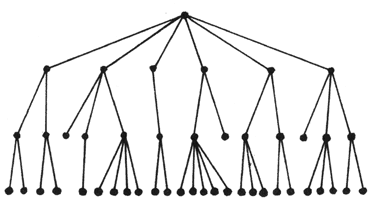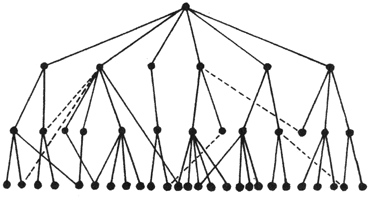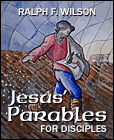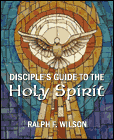Bible Study
New / Special
Jesus
Maturity
Encouragement
Good News
Church
Communion
Prayer
Christian Symbols
Scholarly Articles
Miscellany
Way of the Cross
Holidays
Christmas
Easter
Thanksgiving
Pentecost
St. Patrick's Day
New Year's Day
Steps to Peace with God
Year of St. Paul
About Us
Speaking
Contact Us
Dr. Wilson's Books
Donations
Watercolors
Site Map
Christian Articles Archive
Introduction to Textual Criticism
Why Newer Translations Sometimes Differ Slightly from the KJV
by Dr. Ralph F. WilsonAudio (12:56)
Appendix F in Discipleship Lessons in Luke's Gospel (JesusWalk, 2003, 2010)
 James J. Tissot, 'Saint Mark' (1886-94), gouache on gray wove paper, 6 x 4.67 in., Brooklyn Museum, New York. |
If you've ever studied the New Testament in a group where some use the King James Version and others use newer translations such as the New International Version or the New American Standard Bible, you've probably observed on occasion that the KJV includes phrases that aren't found in newer translations. I want try to explain why in as simple a way as possible, even though this is a very complex subject.
But first, I realize that when I talk about Textual Criticism, some will confuse it with "Higher Criticism" that sometimes seemed like a synonym for modern unbelief. That's completely different. Textual Criticism is the fancy name for the discipline of determining as closely as possible which was the original text of a New Testament Gospel or Epistle as it came from the pen of its divinely inspired author or his secretary. Sometimes people choke on the word "criticism." It doesn't mean to criticize everything; it is a technical term that means, "the scientific investigation of literary documents (as in the Bible) in regard to such matters as origin, text, composition, or history."1435
Types of Copying Errors
We take Xerox copy machines for granted. But in ancient times, manuscripts were laboriously -- and lovingly -- copied by hand, letter after letter, line after line, page after page. If you've ever copied something out of a book, not to mention someone's slightly illegible handwriting, you know that it's easy to make mistakes, even if you check for mistakes again and again. The same kind of minor errors affected copies of various Bible books, too.
- Incorrect divisions between words (spaces were often missing in early manuscripts).
- Confusing one letter for another.
- Skipping from one word to another with a similar ending, omitting a whole group of words.
- Writing a word twice.
- Transposing letters or words.
- Mistakes in understanding a word pronounced by a reader.
- Hearing one word and then inadvertently writing down another with the same meaning.
- Correcting what were considered grammatical or linguistic errors.
- Eliminating apparent discrepancies.
- Harmonizing one gospel with another.
Most of the changes were minor and unintentional. Only rarely would copyists change something so it conformed better with a current doctrinal understanding. Consider how many miniscule errors might be present in a single hand-copied Greek manuscript of the Gospel of Luke. If you counted them all they might number in the hundreds, but have little effect and lie unnoticed.
Autographs and Manuscript Families
But copies of New Testament books weren't just copied a single time. There were copies of copies of copies of copies. Assuming that the original New Testament book or epistle (the "autograph") was without any grammatical or spelling error, each copy of the original would contain some minor errors.


The first diagram shows how copies of manuscripts were derived from original 'Autograph'. The second diagram shows greater complexity with some copies showing influences from other manuscript families. [From J. Harold Greenlee, Introduction to New Testament Textual Criticism (Eerdmans, 1964), p. 14.]
Each copy of the copies would contain the errors of their parent manuscripts and then introduce their own. All told, we've found about 9,000 Greek manuscripts that contain all or part of the New Testament. If you were to conduct a minute study -- and believe me, scholars have -- you could construct "families" of copies based on certain characteristic errors that have been preserved and carried down from an early copy to the hundreds of copies that have been made from it.
External Evidence: The "Earliest" Manuscripts
Scholars have found four major manuscript "families": Alexandrian, Caesarean, Western, and Byzantine. Some of the most important manuscripts containing most or all of the New Testament are named by Latin or Greek letters. The papyrus manuscripts are given a letter P with a superscript, such as P1 or P75. Then you have early translations, such as into Latin, Ethiopic, Syrian, Armenian, etc. In addition there are quotations of many verses in the writings of the Early Church Fathers.
A careful study of characteristic errors in a manuscript may help a scholar place it as "early" (few errors, except the errors common to its family) or "later" (more errors, both the common family errors as well as others that had been introduced). If you want to get as close as possible to the New Testament as the inspired Apostles wrote it -- and that's our goal -- you look for evidence in the very earliest manuscripts. All other things being equal, a particular wording that is attested by several of the earliest manuscripts found in several families is more likely to be correct that the wording found only in an older manuscript all from the same family. Displaying the various manuscripts and families that line up for one wording or another is called examining the "external evidence." When you do this, it frequently becomes obvious which wording (or "reading") is the earliest.
Internal Evidence: Four Guidelines in Textual Criticism
But not always. In some cases, there is strong evidence for two or three different wordings. At that point scholars look for "internal evidence" to guide them to the wording most likely to be the original. Though they aren't set in stone, scholars have developed four principles that guide their thinking about any given wording variation.
- The shorter wording is often preferable. It's generally easier to explain words being added on than words being deleted.
- The harder wording is often preferable. We have a tendency to want to smooth out choppy grammar or "difficult" sayings, to soften them and make them a bit more understandable. Thus, the more "difficult" wording is more likely to be original than a smoother wording.
- The wording from which the other wordings in a variant could most easily develop is preferable. Some of these are like puzzles. When you study them long enough, you can figure out how each of the different wordings could develop from one of the wordings, and if you can do that, you're likely to be correct.
- The wording which is most characteristic of the author is generally preferable. Each of the New Testament authors has his own writing style. It just makes sense that when there's a question, the style most often used by a particular author is the earliest one.1436
Though these principles are helpful, you can see that this is pretty subjective. The great majority of the time, using either external or internal evidence or both, you can be pretty sure of how the original "autograph" was worded. But in a few hundred cases, we just can't be as sure. Usually those cases will show up in newer translations as footnotes displaying an alternate wording.
In addition to technical commentaries, the most helpful book I've found that discusses these decisions between one wording and another, is Bruce M. Metzger, A Textual Commentary on the Greek New Testament (United Bible Societies, 1971, 1995). As you might guess, you need to know some Greek to make much sense out of it. But if you do understand Greek, you'll find this book quite useful.
Does It Make Any Difference?
You may wonder if this textual criticism stuff makes any difference. The answer is, "A little." Today we have an extremely good idea what the original "autograph" manuscripts of the New Testament Gospels and Epistles said -- much better, for example than 400 years ago when the King James Version was translated, relying very heavily on just one manuscript family, the Byzantine family.
Here are examples of two passages that read differently in newer translations than in the KJV due to our better understanding of what was the original wording:
Mark 9:29
And he said unto them, This kind can come forth by nothing, but by prayer and fasting. (KJV)
He replied, "This kind can come out only by prayer." (NIV)
Metzger comments,
"In light of the increasing stress in the early church on the necessity of fasting it is understandable that ['and fasting'] is a gloss which found its way into most witnesses. Among the witnesses that resisted such an accretion are important representatives of the Alexandrian, the Western, and the Caesarean types of text."
The committee Metzger worked with scored this as an {A} probability, {A} meaning "quite certain" and {D} being "uncertain."1437
Luke 9:54-56
And when his disciples James and John saw this, they said, Lord, wilt thou that we command fire to come down from heaven, and consume them, even as Elias did? But he turned, and rebuked them, and said, Ye know not what manner of spirit ye are of. For the Son of man is not come to destroy men's lives, but to save them. And they went to another village. (KJV)
When the disciples James and John saw this, they asked, "Lord, do you want us to call fire down from heaven to destroy them?" But Jesus turned and rebuked them, and they went to another village. (NIV)
Metzger comments:
"The reading 'even as Elias did,' as well as the longer readings in verses 55 and 56, had fairly wide circulation in parts of the ancient church. The absence of the clauses, however, from such early witnesses as P45,75 א B L Xi 1241 it1 syrs copsa,bo suggests that they are glosses derived from some extraneous source, written or oral."
Metzger's committee scores this as a {C} probability, "somewhat uncertain."1438 I could go on, but that gives you the idea.
Can We Believe the Bible?
After reading all this you might get the idea that you can't really believe the Bible. Not so. I've delved into these matters and believe, even more strongly than before, that the Bible we have today can be trusted, and is more reliable even than the Bibles that were available a couple of centuries ago. No major doctrine of Christianity is affected by any of the common wording variations. These involve minor points only. The thousands of Greek manuscripts that exist are strong evidence to the certainty and trustworthiness of our Bible.
[an error occurred while processing this directive]Endnotes
[1435] Merriam Webster, p. 275.
[1436] J. Harold Greenlee, Introduction to New Testament Textual Criticism (Eerdmans, 1964), pp. 114-115.
[1437] Bruce M. Metzger, A Textual Commentary on the Greek New Testament (United Bible Societies, 1971), p. 101.
[1438] Metzger, pp. 148-149.
Copyright © 2024, Ralph F. Wilson. <pastor![]() joyfulheart.com> All rights reserved. A single copy of this article is free. Do not put this on a website. See legal, copyright, and reprint information.
joyfulheart.com> All rights reserved. A single copy of this article is free. Do not put this on a website. See legal, copyright, and reprint information.
 |

|
In-depth Bible study books
You can purchase one of Dr. Wilson's complete Bible studies in PDF, Kindle, or paperback format -- currently 48 books in the JesusWalk Bible Study Series.
Old Testament
- Abraham, Faith of
- Jacob, Life of
- Moses the Reluctant Leader
- Joshua
- Gideon
- David, Life of
- Elijah
- Psalms
- Solomon
- Songs of Ascent (Psalms 120-134)
- Isaiah
- 28 Advent Scriptures (Messianic)
- Daniel
- Rebuild & Renew: Post-Exilic Books
Gospels
- Christmas Incarnation (Mt, Lk)
- Sermon on the Mount (Mt 5-7)
- Luke's Gospel
- John's Gospel
- Seven Last Words of Christ
- Parables
- Jesus and the Kingdom of God
- Resurrection and Easter Faith
Acts
Pauline Epistles
- Romans 5-8 (Christ-Powered Life)
- 1 Corinthians
- 2 Corinthians
- Galatians
- Ephesians
- Philippians
- Colossians, Philemon
- 1 & 2 Thessalonians
- 1 &2 Timothy, Titus
General Epistles
Revelation
Topical
 To be notified about future articles, stories, and Bible studies, why don't you subscribe to our free newsletter, The Joyful Heart, by placing your e-mail address in the box below. We respect your
To be notified about future articles, stories, and Bible studies, why don't you subscribe to our free newsletter, The Joyful Heart, by placing your e-mail address in the box below. We respect your